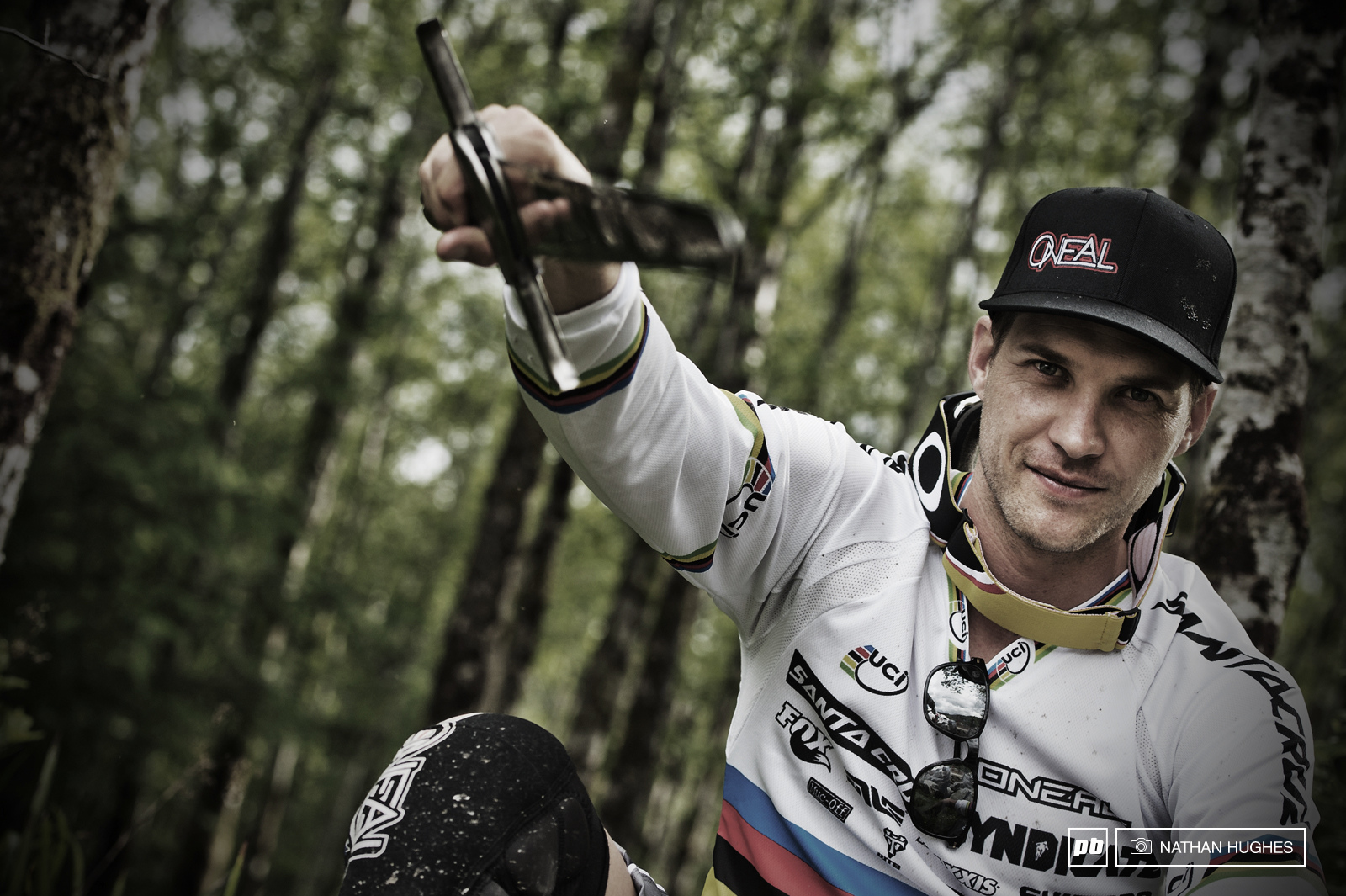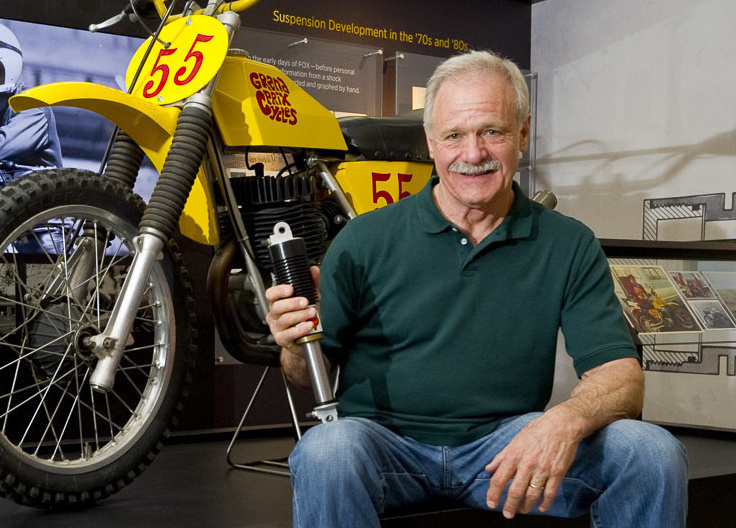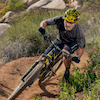1 Question - What Product, Event or Trend has had the Greatest Effect Upon the Sport this Millennium?

Max Commencal - Founder, Commencal
 | Much has changed since the beginning of the millennium in the world of MTB, particularly in terms of distribution, with the arrival of direct selling online, which has dramatically changed the habits of consumers. Perhaps the biggest change, in my opinion, is the arrival of bikes that can be called "universal." For a long time we thought it was necessary to have at least four or five bikes in the garage, allowing us to be able to ride anywhere and everywhere. Big mistake! Now, with the arrival of the modern "All Mountain" bike, everything becomes possible. With 160mm travel, a telescopic seat post, 650B wheels and a 1X transmission... Voila! Long distances, climbs, descents, Bike Park - everything is easily possible. The bike is lighter, stronger and more playful, therefore it's the perfect accessory for those who don't go anywhere without their bike. That's what we did with our META AM and we're proud of our achievement! |

Greg Minnaar - DH World Cup and World Champion, Santa Cruz Syndicate rider
 | To me, there are definitely a couple things that have had huge effect on our sport since I turned pro in 2000, but only a couple. I'm gonna' go with carbon fiber. If I go back, my 2001 World Cup title bike (my Orange 222) was completely aluminum and the only carbon piece on the bike was the seatpost. My 2012/2013 World Champion Santa Cruz V10cc is a complete carbon frame with carbon bars, seatpost, seat rails, and wheels. Carbon has a great feel and there's a ton of benefits, like weight and handling, but only if it's done right and the manufacturers are on top of their game. One thing it certainly does is sort the men out from the boys (Manufacturers). It's easy to make a crap bike out of carbon and, with the expense of tooling, you'll still see some odd bikes and even aluminum bikes raced at the World Cups. |

Andrew Juskaitis - Senior Product Marketing Manager, Giant Bicycles
 | You gotta hand it to Stan Koziatek to develop a product that has truly revolutionized the sport of mountain biking. At 220 pounds, I used to flat just about every ride. With the introduction of Stan's Sealant, I now only flat about twice per year. His product (coupled with tubeless tire technology) gives every off-road rider the piece-of-mind to ride more aggressively over rougher terrain without the fear for the dreaded snake-bite puncture. In addition, every rider can benefit from the added control and capability of running lower PSI's. And while there are many imitators these days, no one does it better than Stan. If I ever run into this dude, I'm gonna give him a big hug - I love his product that much. |

Bob Fox - Founder, Fox Factory
 | Between a "single product, event or trend" I would say a trend has had the most profound effect - specifically the trend within the mountain biking community and industry to continue pursuit and development of new bike types and new riding categories and sub-specialties. Pre-2000, mountain bikes and mountain biking pretty much fit into two main categories: cross country and downhill. Now, 15 years later, we have a modest proliferation of mountain bike types and riding categories. In fact - to such a degree that there can be confusion and overlap when trying to distinguish them. We still have cross country and downhill, but now we also have "Freeride," "All mountain," "Enduro," "Dual Sport," "Fat bike," etc, etc. Good stuff... These added categories and sub-specialties help drive improvements and innovations at a more accelerated pace. As a result, mountain biking overall reaches and serves a broader audience, while enjoyment in all riding categories is enhanced, thanks to continually improved equipment. That's the way it should be - and tends to be - in many other sports and recreational activities. However, it is my view that in mountain biking, this trend of creating new categories and sub-specialties is stronger than in most others. And I believe it will continue for many more years into the future. |

Joe Murray - MTB Hall of Fame legend, Designer, Voodoo Cycles founder, Shimano test rider
 | To me it's a no brainer: frame suspension. What affects the ride more than anything, how efficiently it climbs and how smooth it descends? All other parts that bolt on to these amazing frames have changed dramatically as well, yet I think they would not mean nearly as much without the level of suspension technology we have now. Imagine bolting 90s parts to a cutting edge carbon trail frame... if that was possible. Now imagine bolting all new top end parts to any suspension frame from the 90s. What bike would you choose? Second choices to reinforce my argument would be perhaps forks, yet we've had 150mm travel forks since the 90s. Heavier and primitive damping would be easily more tolerated than a 90's era suspension I figure. Even carbon construction - another second place - because a carbon frame with lame suspension would suck way more than an aluminum frame with awesome suspension. What suspension designers call kinematics, has become a more exact science since the year 2000. One of the few aspects of cycling that I still do not understand that well is suspension, because it's damn complicated. I totally respect the designers and all the mind numbing hours at a workstation tweaking loads and leverages. Here is real science, where huge gains in riding efficiency have been realized out of advances in computer technology, kinematics, 3D solid modeling and stress analysis. Cycling is really a cutting edge industry with some of the highest technology available. (Price be damned.) We all want as much technology as possible and I think we are getting even more than we ask for. Suspension design is at the heart of this insane technological push and I feel stoked to be riding this wave. It's an exciting time to be a mountain biker, without a doubt. |

Chris Sugai - President, Co-founder, Niner Bikes
 | While some would predict my answer as obvious, I think the single product, event or trend that has had the most profound effect upon mountain biking since 2000 has to be the efforts of IMBA. IMBA's tireless efforts over the decades have prevented countless trail closures. Now we are seeing the complete reversal and IMBA is now working on making trail building a hot new trend for economic growth. Unfortunately much of their efforts go unnoticed or underappreciated by the mountain bike community. Talking to land managers, local and national governments is not sexy and rarely gets the press headlines, but is more important than any technology that has been developed in the last 15 years in my eyes. |

Matt Robertson - Mountain Bike Product Manager, Shimano
 | The year 2000 seems like a long time ago, and I would consider a bike built in 2000 to practically be unrideable today, but in reality, bikes were already pretty awesome back then. I have memories of epic rides in the 90's that would be just as epic today on the same bike, but my modern perspective would now prevent me from enjoying it as fully. So what has changed? Surely it had to be more than a 29-inch wheel or a tubeless tire. Even products I cannot ride without, like the Shadow Plus rear derailleur or dropper post, are less than singular. I would have to say that the most profound effect upon our sport in the last 15 years was a simple change of perspective from race to trail. Mountain biking is not a sport, it is a lifestyle. As long as mountain bikes were designed solely for the needs of XC and DH racers, the rest of us were left with promising, but inappropriate products that were always just a little off target. It was BoXXer or Sid. 40 pound Lobos or 20 pound noodles. I was tempted to answer this question with the word "Enduro," which I hate already, but the idea of enduro was, and still is, amazing. First of all, an event where the trail is the star, not the riders. MTB riding is all about terrain, not spectators. And an event where people race their bikes, bikes they already own and ride for fun every day, not an event where people race specialty bikes purpose built and useless for anything else. But already we are seeing Enduro go too far, too far - in a cool direction, but still too far. Your average trail bike is now under gunned for the top level enduro courses and riders are building Enduro specific bikes, which stimulate industry development and sales at the shop level, but threaten to leave your average trail rider behind. Once again, you're seated on a bike that is too long, too slack and too sluggish for your local singletrack, so the answer is not Enduro, or any one product or trend, but the perspective that is driving more and more of today's trends - the trail perspective. It is the trail perspective that led to the dropper post, 180mm rotors, and clutch derailleurs. It is the trail perspective that saw 29ers, fat bikes and 27.5. The main difference between the bike I ride in 2015 and the bike I rode in 2000 is that the bike I rode in 2000 was designed by me, but the bike I ride now was designed for me! |

Cameron Zink - Red Bull Rampage and FMB World Tour champion, World Record holder, YT Industries rider
 | Rampage, Duh! |

Dave Weagle - Inventor, Product designer, Design consultant
 | I could take the easy route here and talk about suspension or materials, but at the risk of being a fully engulfed flame bait in the comments section, I'd like to reminisce about mountain biking in the late 90's. At that time, downhill was really coming into what we know it as today. Suspension was nearing the 200mm mark front and rear, and suspension actually started working. Lift serviced downhill meant that you were racing. There was no widespread bike park network yet. Ask anyone who rode DH bikes back then and they will tell you that the most frustrating part of riding downhill was the chain guide. They were ALL junk. Usually, chain guides consisted of one or two thin pieces of metal as a "bash guard" and a collection of hardware store parts. This translated to riders living in constant fear of even touching a rock with their bottom bracket area. To do so meant the end of your race run, and one or two mangled pieces of metal that you needed to hammer with a rock that you found in the pits, just to get your chainring straight enough to pedal at all. This forced downhill and trail bikes to use ridiculously high BB heights, typically 35-40mm higher than today. Then, in 2000, came the often-overlooked impact-absorbing thermoplastic bash guard. Immediately, obstacles that were once avoided like the plague became a ramp to bounce the bash guard off of. BB heights dropped radically, bikes became easier to ride fast in corners, and in racing, speeds increased radically. Instead of threading through the rock gardens, riders attacked them at full speed. Downhill bike geometry got longer lower and slacker, and this translated directly to the trail bikes that we ride today. Today, you can scarcely find a popular metal bash guard. The thermoplastic bash guard was such a simple idea, yet the catalyst for a geometry revolution that mountain bikers of all levels enjoy today. |
MENTIONS: @COMMENCALbicycles, @GiantBicycleGlobal, @foxracingshox, @voodoobike, @NinerBikes, @shimano, @EeehhZink
Author Info:
Must Read This Week
[UPDATED] Final Elite XC Results & Overall Standings from the Mairiporã XC World Cup 2024
42138 views
42138 views
Sign Up for the Pinkbike Newsletter - All the Biggest, Most Interesting Stories in your Inbox
PB Newsletter Signup


But to anyone that's been into the sport since around 2000 and beyond I'd agree..
Without weed, we wouldn't have "brah", "rad", "stoked", "brown pow", "soul", "flow", "gnar" and of course "epic". And without those critical descriptives, mountain biking would, like, totally not exist...
Then they all go home after a hard days work and brown-pow their wife.
Hugely expensive (MRP World Cup with the 2 orange rollers!!) and would instantly fail when introduced to a rock or tree stump, causing the drivetrain to jam.
I had a number of different, early chain guides, and Mr. Dirt's Gizmo was about the best, just before E13 landed and changed everything with the "Supercharger" polycarbonate bash guard and chain device.
DW should also be credited for his suspension design, the Split Pivot used on the Devinci's was an incredible concept, an active suspension system you could actually pedal without requiring heavy compression damping to mute the rider input
Also, his suspension designs definitely pushed the industry very far and very fast. Everybody remember when the Pivot Mach 5 came onto the scene and changed everything?
the problem with the MRP not really the mounting to the BB / frame but it was the thin aluminium alloy bashguards - once impacted would dent, pinch or fold over and cause a drivetrain jam, or rip the roller off its mount on the next pedal rotation.
the introduction of lexan (polycarbonate) bash allowed the chain guard to absorb / deflect impacts that would be terminal for an aluminium alloy or carbon bash
Even Chris Sugai didn't stoop to touting the 29" wheel, pretty nice.
Nice and lite weight too!
When I started riding (2000-2001) there were no trail maps, guidebooks, signposts, trail signs, online resources (ie www.trailforks.com ), or even legal trails. If you wanted to ride a new trail you had only 2 options: A) explore in the woods until you stumbled upon something good, or B) get directions from a friend, which was usually even worse than randomly exploring.
Nowadays I can plan an entire ride from my computer before I go. I can print off a map and bring it with me so I don't get lost. Trail markers and signposts let me know that I'm on the right trail. Even if I don't prepare pre-ride, there are maps in the woods telling me where I am. Heck with Strava I can even gps my ride and see how fast I am compared to other riders!
I think trail access is by far the "thing" that has had the biggest impact on the sport, leading to more participation, greater legitimacy of the sport, and more fun for those of who do it.
IMBA's internationally-accepted trail standards are used in Canadian cities and national parks, and they make it much easier to push through that burocracy and get mountain biking permitted at all.
I complain about IMBA failing because I'm one of the people out there picking up their slack.
As for bike access in the wilderness, that is EXACTLY in IMBA's baliwick. That's national level advocacy, that's their job, as they're the only ones big enough to get a seat at the table, & they're not even trying.
Over here there was a local indoor skatepark that only allowed skaters and not bicycles. Several groups of riders have tried gaining access by demanding them to let cyclists in, but you can already expect what the result was: they received the same attitude back as they showed towards the skatepark owners.
I actually had a different plan and went inside to talk with them to COLLABORATE. They actually liked my idea of giving it a try to allow cyclists every now and then, and that's where it all started. First just some random days to test / see how it goes, and after that went well we made the deal to let cyclists in on their least busy day: because that would be beneficial for them aswell, because all the cyclists will actually show up on that day if it's only once a week (especially in autumn/winter times). Organized one big event in de skatepark to introduce the skatepark to our national cycling scene, and after that it was always super busy with cyclists on their normally quite day, and they were super stoked to have us riding there. Later they even came to me and told me they want to open up for cyclists another day aswell, and which day I think would be best.
Long story short: the best way to win is to make friends, and not enemies.
It's the most effective way and also the way that leaves great vibes for everyone. Even if you would be able to get what you want by making enemies, the tension will always stay.
I understand where you're coming from, & considerate discourse is always preferable to being antagonistic. That said, I've heard IMBA people refuse to even bring the issue up with decision makers. That's not avoiding antagonism, it's refusing to take up the banner for your cause, especially now, when public opinion on the matter isn't as dead set against it any more.
Consider the Arizona Trail: here we have a route intended to provide a scenic adventure through the wilds of the entire state. It's fairly successful in that regard, for hikers & horseback riders: Cyclists have to divert on to roads for large sections of the trail. IMBA should be at the front lines with FS leadership trying to get exceptions to the wilderness act for situations like "state showcase trails," at the very least. Instead, you've got individuals taking up that banner, which is great, but they don't have the resources IMBA does. Their success has been mixed.
So, are wilderness areas open to horses because of some traditional reason, or because of successfully lobbying of ranchers to get grazing allowed in wilderness, & needing a way round up their stock?
In light of those facts, I have no reservation saying that Wilderness, to put it bluntly, isn't really, & that the prohibition against bikes is arbitrary and unjustified.
Regardless of new trails being put in, preserving existing trail networks with a rich history should be a primary goal of IMBA, & not being willing to show up for a 2 hr meeting doesn't show commitment to that cause. In fact, it brings up the question of whether they're more interested in making money for IMBA Trail Solutions, than preserving existing infrastructure.
As for how much a "boon" to the city, it is, ask some other riders who live in cities if they have a trail system within 15mins of their workplace. Ask some real, raw beginners how they feel about Sweetwater, vs the Bunny Trail at Fantasy.
first: less talk and more action, if you are not agree with IMBA or with they do, create your own non profit, support during years, deal with the government and people, and when you finally has the balance, I´m sure not all people are agree, specially selfish people what can´t see more of 2 steps in front. IMBA do stuff for all people in general.
Second: again, if you are not agree with IMBA and what they do, come to South America, where the trails are just a few, and are ´92 style, or better come to Argentina, where you need to drive 1 hour at least to take.... if you have lucky one super steep, rocky, shit trail. because here "trail system", "sustainable trails", "green, blue, black level"...... or any kind of trail what do you have everywhere here is just like sci-fi.
to be honest I think all American what are angry or disagree with IMBA, just cry like a boy full of toy, what don't appreciate what really has.
At any rate, for me, since 2000, nothing changed HOW I rode my bike more than disc brakes.
Downhilling would definitely be possible with v-brakes if DH bikes had v-brake mounts and -rims. But it would be less effective / good because of the modulation. But definitely not impossible. Just like how Aaron Gwin rode the Leogang UCI DH World Cup track without a rear tyre.
No disrespect to the Hammerschmidt though, just stating that it is exactly the opposite of a n/w chain ring.
In 2000, we were riding 40 lb bikes and stuff broke ALL. THE. TIME. Bent cranks, ripped out pedals, tacoed wheels, snapped frames were all common occurrences. In comparison, you can now reliably use something like a Shimano XTR crankset for every discipline of mountain biking. My AM bike weighs the same as my dad's 2000 Norco Charger Deore-level XC hardtail and descends better than my old 45 lb. 2001 Specialized Big Hit.
than ride a super high end modern carbon frame with 90s suspension, old school shifters, cantilever brakes, shitty 3x6 drivetrain that hardly works etc, etc.
I live in the Pacific NW. The biggest difference between now and 2000 is the huge change in trail building philosophies. Huge berms. Perfectly sculpted jumps. Seamless transitions between natural and built features. Trails that are far less prone to erosion. Fast, flowy awesomeness. The trails here today are amazing.
The bikes we have to ride those trails today are awesome, but I'd rather ride 2015 Whistler on a bike from 2000 than vice versa.
Its all about the terrain.
Without frame design good suspension is useless, and without great suspension why bother pushing the design envelope?
Some of the folks here are too young to remember the ass puckering rides of an 80mm fork and a steel hardtail with "xc race" geometry. And they likely wont have tire burn marks on their calfs and bruised chests from their seats.
Go grab your dads bike and "smash berms" and "huck to flat", find out how much easier it is on a modern bike. go to a lift serviced "resort" with a bike from the early 90s and try it, now thats an adventure!
Different wheel sizes.
Dropper posts with remotes.
Strava!
Suspension that works.
Reliability of stuff.
At their current rate Enduro bikes shall evolve into DH bikes.
2. Red Bull (product)
3. Pinkbike (trend)
Go Pro
Read the comments by Bob Fox and Matt Robertson. Now, bike manufacturers are making very high end bikes and developing cutting-edge technology for the 99% of mountain bikers that don't race much (or at all). I'm a gear dork, but my bike has very little technology that was developed for traditional racing formats. Its all about riding awesome terrain.
Maybe its different in the UK, since you guys don't have much vertical. But here in the US and Canada, the emphasis is on building rad trails and pushing boundaries. Who cares about time? For most people out here, it's all about riding new lines and doing things that scare the shit out of you.
Everyone likes to shit on the 'Enduro' thing because its become marketing jargon. But the reason its cool is because its the first racing discipline that is like the riding that normal people do: not a short DH course that takes 2.4 minutes to ride, and not a bunch of loops on a boring XC course that is mostly fire roads. I don't care how long it takes me to ride a trail. My goals are hitting the transition of a jump, doing a drop that I've never had the balls to do before, or riding something with a little more style than the last time. Its all about the myself and the terrain.
^^^
I started riding DH in 2003 with Haye's 9s - which were very common and cheap at the time. Disc brakes were definitely common place in DH racing before 2003.
www.bikemag.com/blog/exclusive-the-brake-that-changed-everything
I can remember how annoying it was if your rims weren't true and the rubbing of pads and inconstancy. Not to mention the huge reduction in stopping power when the rims got wet. I would go out of my way to stay out of puddles to keep the brakes dry. This could possibly account for the north shore ladder bridges origin to keep riders from widening the trails over wet areas. Don't quote me on that last part